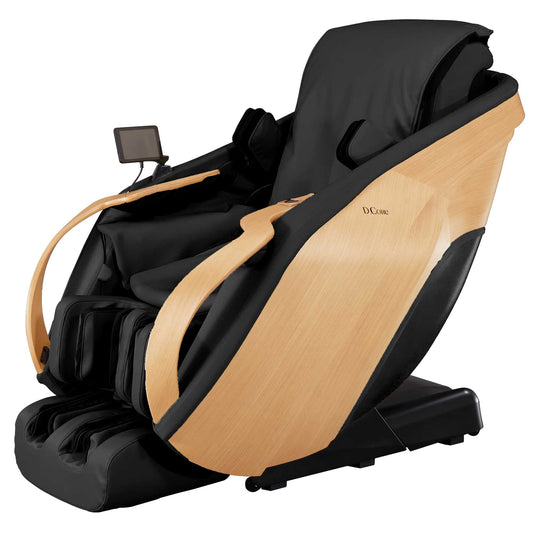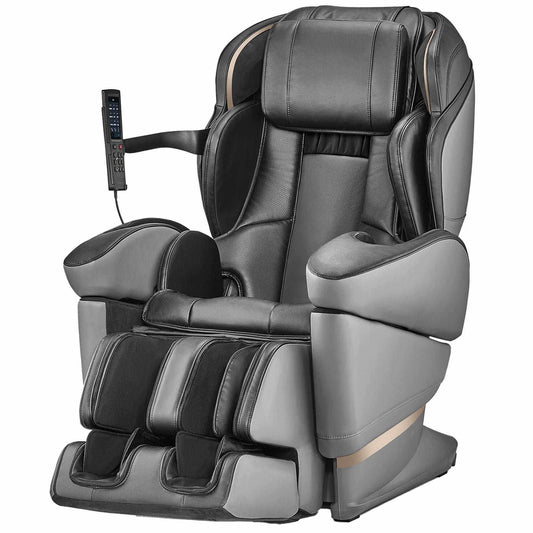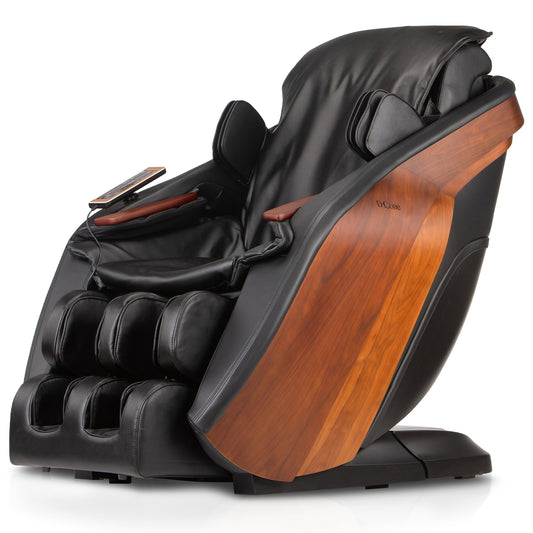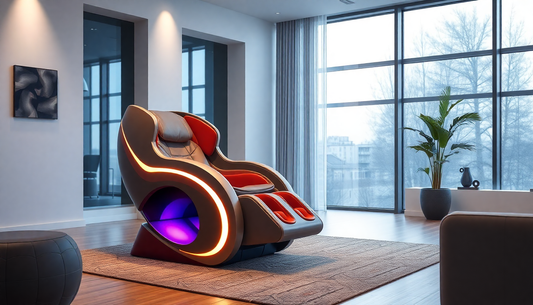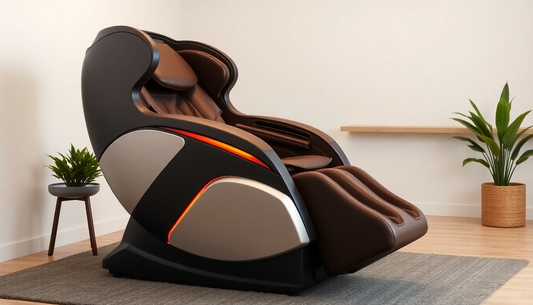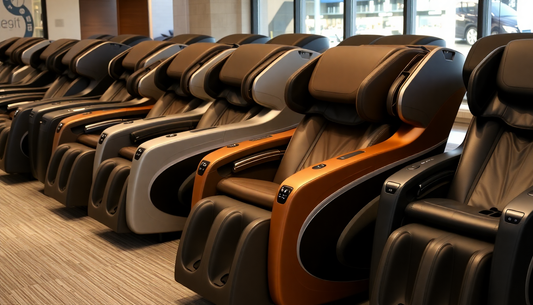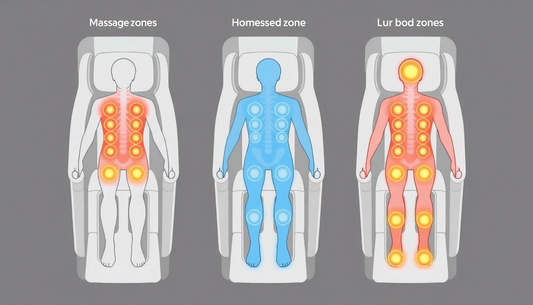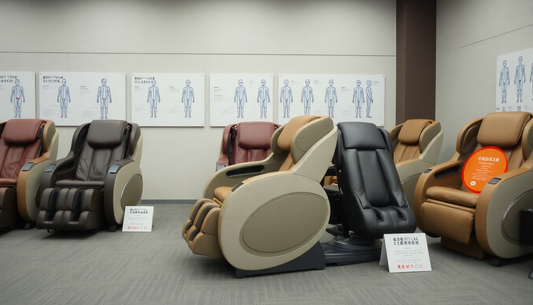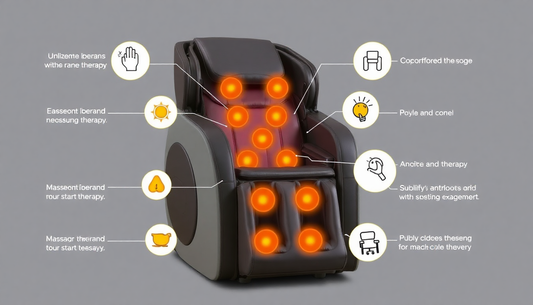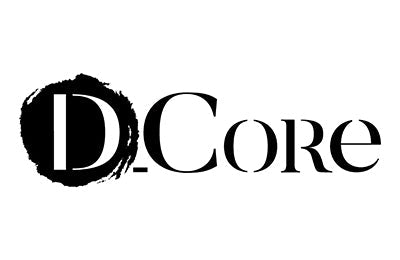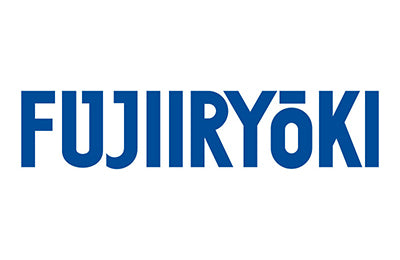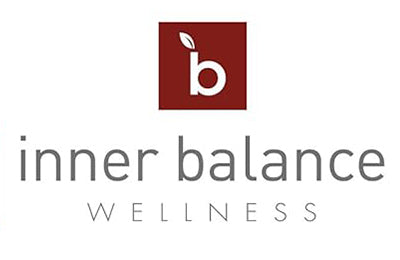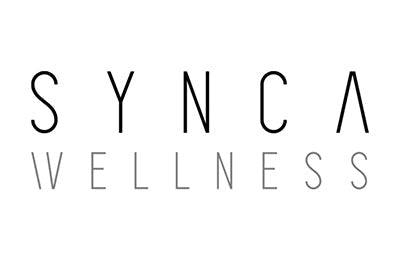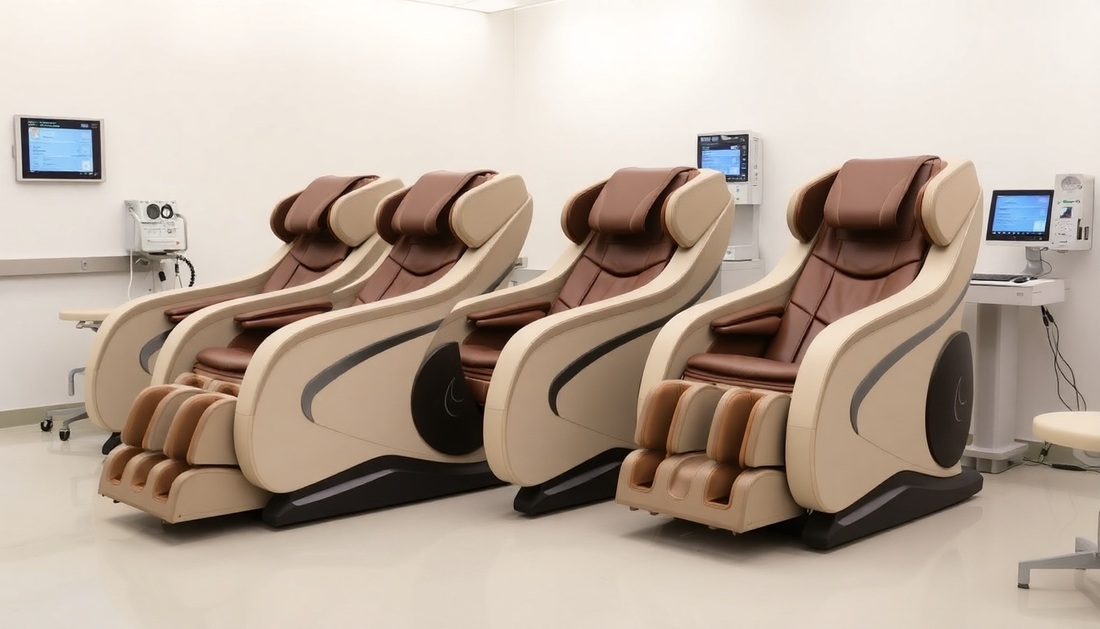
Clinic-Style 4-Day Presentation: Fujiiryoki Calm Plus to Cyber Relax Elite — Daily Massage Techniques, Target Zones (Ankle to Head) & Therapeutic Benefits
Introduction — A Clinic-Style 4-Day Presentation
This extended, clinic-style four-day presentation provides a complete, professional roadmap for deploying Fujiiryoki massage chairs in therapeutic and wellness settings. Each day is dedicated to a single model — Calm Plus, Cyber Relax Ai, Cyber Relax Pro, and Cyber Relax Elite — and presents an ankle-to-head protocol that maps massage techniques to target zones and therapeutic benefits. This resource is meant for clinicians, massage therapists, wellness center managers, and informed consumers who want detailed, reproducible chair protocols that maximize therapeutic value while remaining safe.
How to Use This Presentation
- Implement each day's protocol as a templated session for new clients so you can compare outcomes across models.
- Use measurement metrics (pain scales, mobility tests, sleep quality) before and after a 30–60 day program to quantify benefit.
- Adapt intensity and timing based on client feedback, contraindications, and clinical goals (relaxation vs rehabilitation).
Key Terms: Models, Techniques, Target Zones, Benefits
- Models: Calm Plus, Cyber Relax Ai, Cyber Relax Pro, Cyber Relax Elite
- Techniques: Swedish, Deep Tissue, Trigger Point, Acupressure, Shiatsu, Reflexology, Kneading
- Target Zones: Ankle, Back, Calf, Feet, Hands, Head, Heel, Knee, Legs, Neck, Shoulder, Thigh, Whole Body, Wrist
- Benefits: Blood Flow Control, Fatigue Relief, Flexibility Improvement, Injury Recovery, Muscle Therapy, Pain Relief, Spine Alignment, Stress Relief, Tissue Therapy
Why Model-Specific, Clinic-Style Protocols Matter
Different Fujiiryoki models offer varying degrees of intensity, sensor feedback, and targeted features such as plantar rollers, airbags, lumbar rollers, and head/neck modules. A clinic-style approach standardizes how those features are used so clinicians can reliably reproduce outcomes, document progress, and scale chair therapy across clients with different needs.
Day 1 — Fujiiryoki Calm Plus: Foundation, Relaxation, and Low-Intensity Therapy
Primary objective: deliver a gentle, restorative session that supports autonomic balance, circulation, and early-stage tissue recovery. Calm Plus is the baseline model in this series and excels at comfort-oriented routines that still deliver therapeutic value.
Client Selection & Indications for Calm Plus
- Ideal for clients seeking relaxation, mild-to-moderate muscle tension relief, or initial postural correction.
- Good for older adults or those with low pain tolerance due to its gentle airbags and light kneading options.
- Appropriate as a first-line chair for clients with chronic mild tension who are starting a therapy plan.
Day 1 — Detailed Ankle-to-Head Protocol (Calm Plus)
- Phase 1 — Lower Limb Compression & Warm-Up (10–12 minutes): use alternating airbags for feet, ankles, and calves; combine with low heat if available to improve blood flow control and prepare tissues for deeper work.
- Phase 2 — Plantar Reflexology and Heel Release (6–8 minutes): reduced-speed rollers on the plantar surface with intermittent Shiatsu-style point holds to encourage systemic relaxation and reflex-mediated fatigue relief.
- Phase 3 — Calf & Thigh Effleurage and Light Kneading (8–10 minutes): slow, rhythmic kneading to reduce muscle tension and support early tissue therapy, especially useful after prolonged standing.
- Phase 4 — Lower Back and Lumbar Support (8–10 minutes): gentle rolling and broad kneading across the lumbar area to support spine alignment and reduce diffuse lower-back pain.
- Phase 5 — Upper Back, Neck, and Shoulders (10–12 minutes): long Swedish strokes and gentle acupressure; avoid aggressive pressure in clients with cervical instability.
- Phase 6 — Hands, Wrists, and Cranial Finish (5–7 minutes): mild compression for hands and wrists; light scalp massage and breathing-synchronized strokes to close the session with stress relief.
Clinical Notes & Modifications — Calm Plus
- For sensitive clients, keep pressure low and extend duration to 40–45 minutes to increase benefit without intensity.
- If the client has plantar fasciitis, use slower, shorter plantar cycles with cushioning on the heel area and avoid aggressive rollers.
- Document pre/post-session relaxation score (0–10) and discomfort levels to monitor benefit over time.
Day 1 — Therapeutic Benefits Delivered by Calm Plus
- Immediate stress relief and parasympathetic activation through slow Swedish and Shiatsu rhythms.
- Improved peripheral circulation and reduced leg fatigue via graduated compression.
- Support for tissue recovery and flexibility improvements when combined with home stretching.
Day 2 — Cyber Relax Ai: Smart, Adaptive Personalization for Mixed Needs
Primary objective: leverage adaptive sensor feedback to deliver targeted, moderate-to-deep therapy where it matters most. Cyber Relax Ai uses posture and tension detection to personalize routines, making it ideal for mixed clinic populations.
Client Selection & Indications for Cyber Relax Ai
- Clients with moderate, localized pain or persistent trigger points who need targeted, data-driven intervention.
- Active adults and athletes seeking recovery sessions that adapt to their tension patterns.
- Clients requiring a balance of relaxation and therapeutic depth without the intensity of pro-level chairs.
Day 2 — Detailed Ankle-to-Head Protocol (Cyber Relax Ai)
- Phase 1 — Vascular Prep & Targeted Warming (8–10 minutes): graded compression and moderate heat on calves and feet to mobilize blood flow for deeper work.
- Phase 2 — Sensor-Guided Trigger Point Detection (6–9 minutes): allow the AI to identify regions of hypertonicity in calves, hamstrings, and glutes; apply focused trigger point pressure then alternate with Swedish effleurage to reduce rebound soreness.
- Phase 3 — Lumbar Stabilization and Spinal Mapping (10–12 minutes): adaptive rollers reshape pressure distribution along the spine to improve alignment and reduce paraspinal hypertonicity.
- Phase 4 — Cervical & Shoulder Precision (10 minutes): sensor-optimized Shiatsu and acupressure for trapezius and suboccipital areas; finish with light traction if the chair supports it.
- Phase 5 — Integrated Recovery Cooldown (5–7 minutes): progressive decompression and light kneading to integrate the session and reduce DOMS (delayed onset muscle soreness).
Clinical Notes & Modifications — Cyber Relax Ai
- For clients with acute inflammation, avoid aggressive trigger point sequences; prioritize low-heat, low-pressure cycles with shorter duration.
- Use the AI feedback as a starting point; therapists should manually fine-tune settings when a client reports discomfort or unusual sensations.
Day 2 — Therapeutic Benefits Delivered by Cyber Relax Ai
- Precision pain relief via trigger point and deep tissue targeting aided by sensor-guided mapping.
- Enhanced circulation and faster tissue warm-up from controlled heating and compression.
- Measurable improvements in posture and lumbar comfort when used regularly alongside core strengthening exercises.
Day 3 — Cyber Relax Pro: High-Intensity Therapeutic Workflows
Primary objective: deliver reproducible, clinic-grade deep tissue and trigger point therapy for clients requiring substantial soft-tissue remodeling and rehabilitation support.
Client Selection & Indications for Cyber Relax Pro
- Clients with chronic myofascial pain, repetitive strain injuries, or athletes in high-load sports.
- Clients who have contraindications for manual deep tissue massage but would benefit from controlled mechanical pressure.
- Rehab programs focused on structural change and long-term pain reduction.
Day 3 — Detailed Ankle-to-Head Protocol (Cyber Relax Pro)
- Phase 1 — Deep Lower Limb Conditioning (12–15 minutes): extended kneading and intense compression on calves, hamstrings, and quadriceps to increase tissue pliability for subsequent trigger work.
- Phase 2 — Systematic Trigger Point Mapping and Release (10–12 minutes): sequentially apply focused pressure to known trigger point loci—gastrocnemius, hamstring insertion, iliotibial band proximals—follow each release with controlled effleurage to flush metabolic byproducts.
- Phase 3 — Targeted Lumbar Remodeling and Decompression (12–15 minutes): high-precision rollers and stronger acupressure patterns encourage spinal alignment and reduce chronic paraspinal tension.
- Phase 4 — Upper Quadrant Intensive (10–12 minutes): deep kneading and trigger point work for trapezius, levator scapulae, and neck extensors; include short rests between high-intensity passes.
- Phase 5 — Extended Therapeutic Cooldown (6–8 minutes): slow Swedish strokes, intermittent compression, and gentle headwork to minimize soreness and support tissue repair.
Clinical Notes & Modifications — Cyber Relax Pro
- Because of its intensity, this model should be used by trained staff or under therapist guidance for clients with complex pain.
- Consider pre-session hydration and post-session light movement to aid recovery when using deep protocols.
- Document functional measures such as sit-and-reach, cervical rotation, and single-leg balance before and after a multi-week program.
Day 3 — Therapeutic Benefits Delivered by Cyber Relax Pro
- Substantial muscle therapy and tissue remodeling for chronic tension and athletic recovery.
- Accelerated injury recovery when combined with active rehab protocols and clinician oversight.
- Measurable reductions in chronic pain intensity and improved range of motion over multiple sessions.
Day 4 — Cyber Relax Elite: Comprehensive Whole-Body Clinical Integration
Primary objective: provide top-tier, staged therapy combining all techniques and features to deliver maximum therapeutic benefits and autonomic regulation. Elite is the peak model intended for clinics that want one chair to serve many therapeutic roles.
Client Selection & Indications for Cyber Relax Elite
- Clients needing whole-body integration, including athletes, chronic pain patients, and clients with multi-site tension.
- Clinics aiming to offer premium chair-based therapy as part of multidisciplinary care.
- Programs that combine chair therapy with physical therapy, chiropractic care, or medical monitoring.
Day 4 — Detailed Ankle-to-Head Protocol (Cyber Relax Elite)
- Phase 1 — Graduated Vascular & Lymphatic Prep (10 minutes): advanced compression cycles to mobilize venous return and stimulate lymphatic drainage for improved blood flow control and reduced swelling in distal limbs.
- Phase 2 — Deep Plantar Reflexology & Heel Decompression (8 minutes): complex plantar sequences that mix rollers, Shiatsu holds, and cushioning to address plantar pathology without provoking pain.
- Phase 3 — Integrated Deep Tissue + Trigger Point Module (15 minutes): multi-depth rollers, synchronized airbags, and targeted acupressure to treat legs, pelvis, lumbar, and thoracic trigger points for injury recovery and muscle therapy.
- Phase 4 — Structural Alignment and Upper Cervical Reset (12 minutes): coordinated spinal decompression, acupressure along vertebral column, and suboccipital release to support spine alignment and autonomic balance.
- Phase 5 — Cranial & Autonomic Cooldown (6–8 minutes): gentle scalp and facial work integrated with breathing cues, finishing with slow full-body sweeps to promote deep stress relief and improved flexibility.
Clinical Notes & Modifications — Cyber Relax Elite
- Elite supports multi-purpose therapy; document which combination of modules is used each session for reproducibility.
- For clients with high sympathetic tone, extend cranial cooldowns and include guided breathing to maximize stress-relief outcomes.
- For athletes, consider replacing part of the cooldown with targeted stretching sequences or dynamic compression to aid return-to-play timelines.
Day 4 — Therapeutic Benefits Delivered by Cyber Relax Elite
- Comprehensive whole-body therapy combining blood flow control, tissue therapy, and spinal alignment.
- Superior stress relief and autonomic regulation through integrated Shiatsu and cranial techniques.
- Strong support for injury recovery and flexibility improvement when incorporated into multi-modal care.
Technique-to-Benefit Mapping — Expanded
- Swedish Massage: long effleurage and broad strokes support venous return, reduce resting muscle tone, and improve flexibility improvement when repeated.
- Deep Tissue Massage: concentrated pressure on deeper layers reduces chronic hypertonicity and facilitates pain relief and muscle therapy.
- Trigger Point Massage: localized pressure releases neuromuscular focal points, supporting injury recovery and immediate pain reduction.
- Acupressure: point-based pressure balances autonomic output and contributes to spine alignment through reflex pathways.
- Shiatsu: rhythmic compressive sequences help regulate the nervous system and produce sustained stress relief and improved sleep.
- Reflexology: plantar and hand reflex work supports systemic relaxation and targeted fatigue relief.
- Kneading: deep, repetitive manipulation remodels soft tissue to improve flexibility improvement and reduce post-exertional soreness.
Session Timing Recommendations — Expanded
- Express Maintenance: 20–30 minutes — ideal for breakroom clinics or quick workplace recovery.
- Standard Clinical Session: 30–45 minutes — balances therapeutic depth and throughput for outpatient settings.
- Therapeutic Session: 60–90 minutes — recommended for deep tissue protocols, multi-zone rehabilitation, and athletes.
- Program Frequency: acute issues 2–4x/week; chronic maintenance 1–2x/week; athlete peri-competition sessions 2–5x/week depending on load.
Intake, Screening & Safety Protocols (Detailed)
- Pre-screen: document medical history, current medications (especially anticoagulants), recent surgeries, pregnancy status, and sensory neuropathy.
- Contraindications: deep vein thrombosis, uncontrolled hypertension, active infection, recent fractures, acute inflammatory conditions, and unstable cardiovascular disease.
- Client education: explain expected sensations, post-session fatigue, and the importance of hydration and gentle movement after deep sessions.
- Monitoring: check blood pressure and pain levels for high-risk clients and allow immediate adjustment of intensity.
Documentation Templates & Outcome Measures
- Intake form: baseline pain scale (0–10), body diagram of pain locations, mobility metrics (ROM), and sleep quality rating.
- Session log: model used, program name, duration, intensity level, targeted zones, client comfort notes, and objective findings.
- Outcome tracking: weekly pain scores, ROM changes, mood/stress ratings, medication use, and return-to-activity timelines.
Case Studies & Practical Examples
- Case 1 — Office Worker with Neck/Upper Back Tension: 6-week Calm Plus program, three 30-minute sessions/week. Outcomes: reduced pain scores from 6/10 to 2/10, improved cervical ROM, improved sleep quality.
- Case 2 — Runner with Calf Tightness and Plantar Pain: 8-week Cyber Relax Ai program, two 45-minute sessions/week combined with eccentric calf loading. Outcomes: reduced calf tightness, improved single-leg hop, decreased plantar discomfort with progressive loading.
- Case 3 — Competitive Athlete Post-Game Recovery: Cyber Relax Pro immediate post-game 45–60 minute sessions, combining compression, deep tissue, and targeted trigger point release. Outcomes: faster perceived recovery and improved readiness metrics within 48 hours.
- Case 4 — Multi-site Chronic Pain Patient: Cyber Relax Elite weekly 60-minute integrative sessions as part of multidisciplinary care. Outcomes: decreased overall pain medication reliance and improved functional mobility at 12 weeks.
Training Checklist for Staff
- Understand model-specific features and safety protocols for each model.
- Train on intake screening and contraindication recognition.
- Practice adjusting programs, intensity, and timing based on client feedback.
- Learn to document and measure outcomes consistently for quality improvement.
Maintenance, Hygiene & Operational Best Practices
- Daily: wipe head and arm contact surfaces with approved disinfectant; empty and inspect foot modules.
- Weekly: inspect airbag integrity and run diagnostic self-tests per manufacturer guidance.
- Monthly: schedule professional maintenance for rollers, motors, and electronics according to Fujiiryoki manuals.
- Hygiene: use clean disposable covers when appropriate and follow local infection control guidelines.
Marketing & SEO Guide for Clinics (2025)
- Title tag suggestion: Clinic-Style Fujiiryoki Protocols — Calm Plus to Cyber Relax Elite for Pain Relief & Recovery.
- Meta description suggestion: Discover clinic-tested ankle-to-head protocols for Fujiiryoki chairs. Model-specific daily routines, techniques, target zones, and measurable benefits for clinics and athletes.
- On-page: use H2s for each model and target zone. Add FAQs and schema for better SERP presence.
- Content marketing: publish case study videos, clinician interviews, before/after mobility data, and infographics mapping techniques to benefits.
- Local SEO: create specific pages for chair-based services and optimize for local search terms like "massage chair therapy near me" and model names paired with clinical keywords.
Common Questions & Expanded FAQ
- Q: How soon will clients feel benefit? A: Many report immediate relaxation and reduced muscle tension after one session; deeper structural changes typically require multiple sessions over weeks.
- Q: Can chairs replace manual therapy? A: Chairs are a powerful adjunct; they complement manual therapy and rehab but do not replace hands-on assessment and certain manual techniques.
- Q: How to choose the right model? A: Choose Calm Plus for gentle relaxation programs; Cyber Relax Ai for adaptive, mixed-intensity needs; Cyber Relax Pro for intensive therapeutic work; Cyber Relax Elite for comprehensive, integrative programs.
- Q: Are there objective ways to measure improvement? A: Yes — use pain scales, ROM tests, timed functional tests, sleep quality ratings, and activity readiness data where applicable.
Evidence Summary & Professional Context
Mechanical massage and compression therapies have documented benefits for circulation, short-term pain relief, and autonomic regulation. In clinical practice, combining chair-based therapy with exercise, ergonomics, and multidisciplinary care improves long-term outcomes. Always align protocols with current clinical guidelines and client-specific medical advice.
Sample 30-Day Implementation Plan for a Clinic
- Week 1: Staff training, baseline outcome measures for initial clients, and pilot Calm Plus programs for relaxation-focused clientele.
- Week 2: Begin Cyber Relax Ai sessions for medium-intensity cases; collect weekly outcome data and client feedback.
- Week 3: Introduce Cyber Relax Pro for therapeutic referrals and athletes; run weekly staff case reviews to refine protocols.
- Week 4: Launch Cyber Relax Elite premium program and compile 30-day outcome report to inform pricing, scheduling, and marketing.
Printable Protocol Checklists (Summary)
- Calm Plus Checklist: Intake, foot warm-up 10–12 min, plantar release 6–8 min, back/neck 20 min, finish 5–7 min.
- Cyber Relax Ai Checklist: Vascular prep 8–10 min, AI trigger mapping 6–9 min, lumbar 10–12 min, neck 10 min, cooldown 5–7 min.
- Cyber Relax Pro Checklist: Lower limb conditioning 12–15 min, trigger mapping 10–12 min, lumbar remodeling 12–15 min, upper quadrant 10–12 min, cooldown 6–8 min.
- Cyber Relax Elite Checklist: Graduated vascular prep 10 min, plantar release 8 min, deep tissue + trigger 15 min, alignment reset 12 min, cranial cooldown 6–8 min.
Final Recommendations
Use this 4-day clinic-style presentation as both a clinical playbook and a marketing differentiator. Standardize intake, documentation, and outcome measures to show measurable benefit from chair-based interventions. Iterate protocols based on client feedback and objective data to refine settings for your population.
Closing Call to Action
Start with one model and run a short pilot to collect outcome data. If you operate a clinic, create a client-facing brochure that explains the ankle-to-head sequence and the expected benefits for each model. With structured implementation and careful documentation, Fujiiryoki chairs can become a reliable part of your clinical toolkit for stress relief, injury recovery, and long-term functional improvement.
